
 |
||
| Home Grammar Lessons > Introduction I 1 2 3 4 5 6 II 1 2 3 4 5 6 III 1 2 3 4 5 6 IV 1 2 3 4 5 6 V 1 2 3 4 5 6 VI 1 2 3 4 5 6 Select Unit | ||
|
| ||||||||||||||||||||||||||||||||||||||||||||||||||||||||||||||||||||||||||||||
Question WordsQuestion words in Tamil can occur freely in more than one position in a sentence. Depending upon where they occur and how the stress is placed on them, they have slightly different meanings. For example, யார் முருகன்? would mean 'who is Murugan?' but the question முருகன் யார்? with an extra stress on the word யார் can mean 'who do you think Murgan is?'. Both of these questions in normal utterances can also mean 'which person is called Murgan?' or 'who is called Murukan?'. The following table provides a list of question words along with their spoken form.
Question words and deictic setsEvery language has a class of expressions called 'deictic.' Here this simply means words that refer by 'pointing to' some.htmlect of the context. The reference of such words, then, vary depending on the context: e.g., who is speaking, where you are, etc. In English, 'I', 'you, 'he', 'she', 'that', 'there', etc., are deictics.We have already seen a number of such constructions in Tamil: நான், நீங்கள், நீ, அவர், அவர்கள், அது,, etc. In addition, some deictics tend to occur in contrastive paradigms: e.g., in English, 'here/there/where', 'this/that/which', etc. In Tamil, such constrastive paradigms are extremely regular and vary by the first letter: இ, அ, எ (proximate, distal, question). Consider the following deictic sets:
Dialogue: unit_01/section_A/lesson02.html | ||||||||||||||||||||||||||||||||||||||||||||||||||||||||||||||||||||||||||||||
|
© South Asia Language Resource Center (SALRC) |